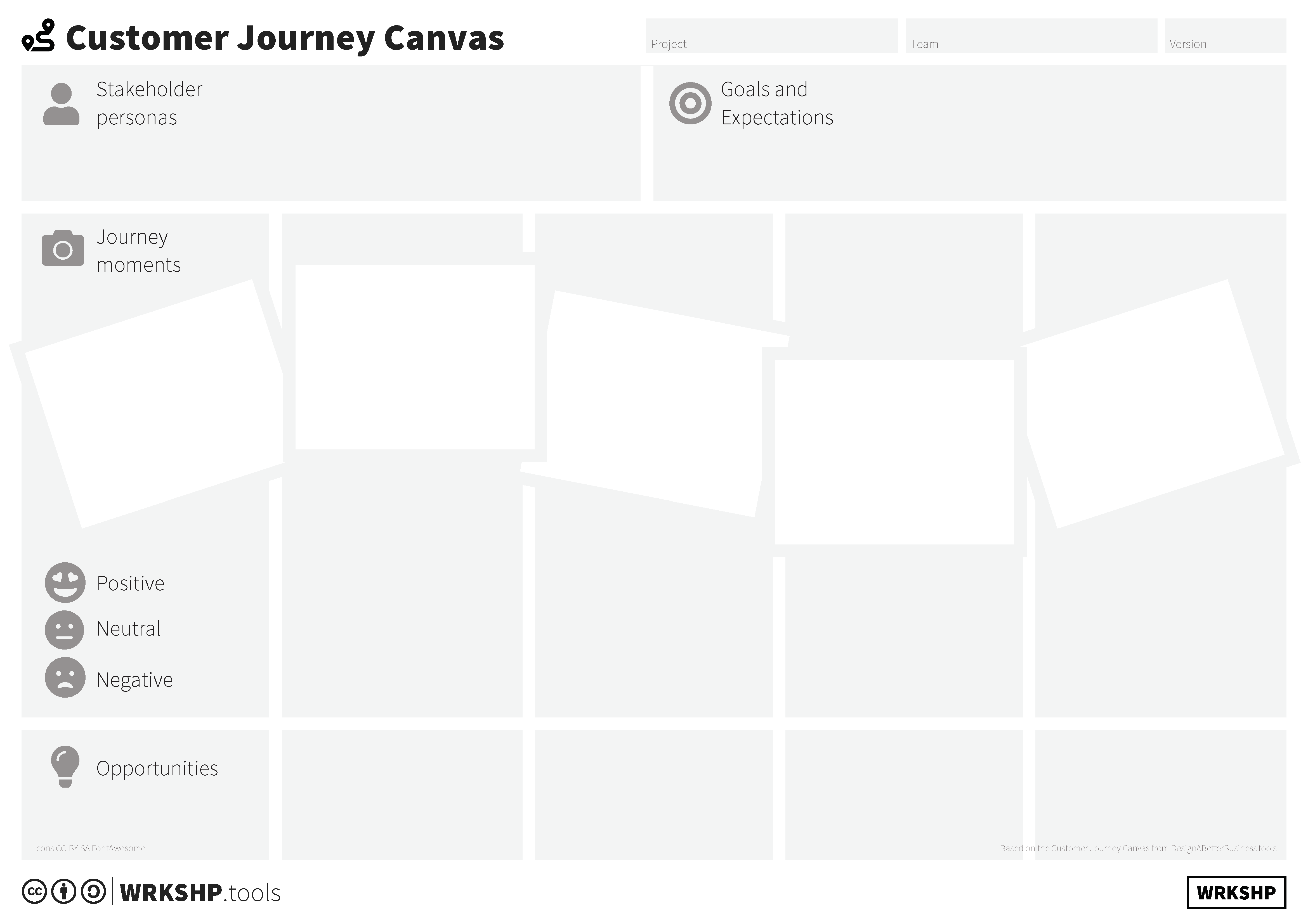Customer Journey Canvas
The Customer Journey is a tool to help you get insight into, track, and discuss how a customer experiences a problem you are trying to solve.
Use this tool when:
Overview
| Time | ± 45 minutes | |
| Difficulty | 3 / 5 | |
| People | 3 - 5 | |
| Author | erik van der pluijm | |
| Website | ||
| License | CC BY SA 4.0 |

What is it and when should I use it?
The Customer Journey is a tool to help you get insight into, track, and discuss how a customer experiences a problem you are trying to solve. How does this problem or opportunity show up in their lives? How do they experience it? How do they interact with you?
Mapping this journey will provide you with insights into how customers experience a product or service, as well as how they might be better served or even delighted. This is especially true when co-creating the journey together with your customers or when validating your assumptions with them. What are the circumstances? How do customers feel throughout? What are the moments when the experience can best be improved?
Customer journeys are not linear. A customer can jump from one phase to another depending on many factors. They interact with some touch points and miss out others. It is your job, as a designer, to understand the moments when customers engage so that you can design better experiences for them in the future. This tool helps in looking at your products and services through the lens of the customers.
Of course, no customer journey is totally complete or made without assumptions. Mapping the customer journey is based on the knowledge and insights of your team. This tool simply helps you understand and explore from the customer’s point of view.
The customer journey canvas helps make things real. Through the mapping exercise you can identify where customers get stuck, where they have great experiences, and why. One outcome of using this tool with your team will be the so-called low hanging fruit that you can deliver on immediately. Once you have co-created and assembled the customer journey maps, you can add real customer data gathered through customer safaris, interviews, and feedback. This will enable you to make informed decisions based on reality.
The customer journey is relevant for everyone. Everyone on the team, and in your company, must understand what your customers experience, how they feel, what they struggle with, and how you can improve the experience. The underlying goal: to solve our customers’ problems and make them happy.
Tool Overview

Stakeholder personas The customer that experiences the journey is your stakeholder persona.
Goals and expectations The goals and expectations for the stakeholder personas.
Journey moments The moments (‘touch points’) that are memorable for the customer.
Emotional states How does the customer feel when he/she experiences these moments?
Opportunities What are the opportunities to improve the customer experience for these moments?
Steps
1 Defince your customers
To make a good customer journey, you need to define who it is for. Who is the customer you are going to follow? And easy way to do this is by using the persona canvas. You don't want to specify generic customer segments here, but start from specific customers, that you know. This will help enrich the journey. Generalizing it comes later.
2 Map the Journey
With the team, come up with moments in the journey of your customer. Think from that customer's perspective. His or her goal in life is not to buy your product or use your service, that is (usually) a means to an end. What end is that? How do they experience the problem you are trying to solve? And do they really experience it? What do they currently do to deal with that problem?
While you are defining moments for the customer, try to place them in an order. That could be a short interval, for example a day in the life of the customer, or a longer duration. The goal is to find the meaningful moments for the customer first, and then to look for the touchpoints where your product or service comes into the picture.
An easy way to build moments is to think of what happened first (what would be the movie frame for that moment?) and then to proceed what the customer thinks or feels, and ultimately what their needs are. Make sure it's their needs, don't sneak your product back in!
3 Challenge your assumptions
Now that you have mapped out a lot of moments, it's time to challenge assumptions. So far, almost everything you have done is an assumption, starting from what you know about the customer, and going all the way to their needs in specific moments. Some of these assumptions are more impactful than others. They need to be checked before you start building product ideas on top of them. To do this, you need to go out of the building, and run experiments.
Show your journey to actual or potential customers, and see if they recognize themselves. What is their journey? Map it out with them. Once you have done that, you will start to see patterns and learn what the actual needs are that they have. Sometimes they may not even know it themselves!
4 Next Steps
Check the following items to see if you have worked enough on the Customer Journey.
- Was the persona specific enough?
- Is the journey complete? Are any key moments missing?
- Ask yourself where the journey really starts and ends. Are there moments before and after that you should include?